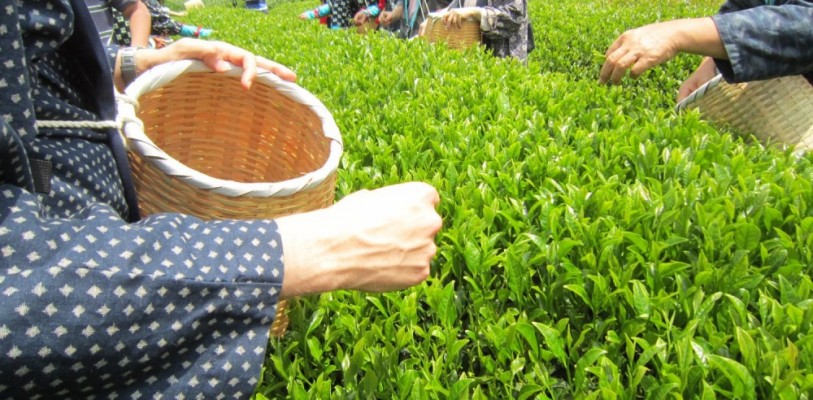
Did you know some tea companies add fillers to their matcha powdered green tea to prevent caking and increase the weight? I had no idea that this was something I needed to worry about, or even question, until I came across it for the first time a few weeks ago.
My eyes were opened at a green tea shop in Bangkok, Thailand. Every time I’m in Bangkok, I head to this one place called Cha-ho, because they sell fresh matcha drinks without sugar, or so I thought.
If you’re wondering, it’s actually hard to find green tea drinks without sugar outside Japan, even in other parts of Asia. Surprising – I know, especially since China is the origin of traditional green tea.
So, I’m drinking my delicious iced matcha and thinking about how it tastes different than matcha in Japan. It lacked the strong matcha flavor I’ve come to love and it was sweeter than usual, even though I ordered it unsweetened.
I saw the container of matcha in the shop and asked if I could take a look. I thought it was possible that it could be from a different country.
What I saw will shock you! The label read 89% maltodextrin, 11% matcha! What? I never knew that could exist! My seemingly healthy drink was almost all sugar!
It turns out that this filler is a common ingredient in instant green tea mixes. There are many reasons why companies choose to add it.
Tealux’s description for their Imperial Matcha-2-Go says, “By blending Matcha with maltodextrin, we have eliminated Matcha clumping, making it easier to mix into hot water without needing a whisk or to even sift the tea first.”
Maltodextrin is a polysaccharide, a type of carbohydrate. It is produced from a starch, such as corn, wheat, potatoes, or rice, similar to corn syrup. It is used as a thickener in a variety of foods from salad dressings to soups and gravies to canned fruits.
First, maltodextrin has a higher glycemic index than regular sugar! Its glycemic index is 106 – 136 compared to sugar’s 65. What does this mean? Foods with a higher glycemic index make your blood sugar spike faster. This in turn has an impact on your insulin levels.
If you continue to eat foods with a high glycemic index, your body will create more and more insulin to regulate the blood sugar. This can potentially be dangerous for people with diabetes or hypoglycemia.
Second, maltodextrin can rid your body of valuable vitamins and minerals because it uses more than it provides. So, your body must use its own reserves of vitamins and minerals to digest it.
Lastly, if you’re concerned about GMO’s, then it might be worth knowing that the majority of maltodextrin in the United States is made from genetically modified corn. In Europe, it is mostly made from wheat.
Read ingredient lists of powdered green tea mixes. Even if it is unsweetened, it can still contain unwanted additives.
Lipton recently came out with Iced Green Tea To Go Packets in many flavors. It sounds enticing because you can just pop the contents of the packet into your water bottle. Here’s a look at all the ingredients from the Mango Pineapple flavor.
Ingredients: Honey Granules (Sugar, Honey), Citric Acid (Provides Tartness), Green Tea Powder, Sucralose (Sweetener), Maltodextrin (Corn), Hibiscus Extract, Natural Flavor, Beta Carotene (For Color).
I love Trader Joe’s, but this product is disappointing with its list of 14 ingredients. I find the following statement amusing, since they’ve added a lot more than milk and sugar.
“Because straight Matcha is a little bitter, we couldn’t resist adding some milk and cane sugar to our mix.” – Trader Joe’s
Again, like my drink in Bangkok, you can see in the ingredient list that there is more maltodextrin than matcha. It makes you wonder about the percentages of each one.
Ingredients: Cane Sugar, Coconut Oil, Maltodextrin, Matcha Green Tea, Whole Milk Powder, Non Fat Milk Powder, Malted Milk Powder (Barley Malt, Wheat Flour, Milk, Bicarbonate of Soda, Salt), Natural Flavors, Sodium Caseinate (a Milk Derivative), Tricalcium Phosphate, Guar Gum, Mono and Diglycerides, Silicon Dioxide, Salt.
If in doubt, buy authentic Japanese matcha. That way you know you are getting 100% of the health benefits. Quality matcha is not bitter and naturally has a slightly sweet taste. To prevent clumping in your glass, sift the matcha through a strainer.
When possible, check labels for ingredients, and ask cafes for the list of ingredients in their green tea and matcha. There could be more in your favorite matcha drink than you think!
This article contains a link to DailyMatcha.com. Daily Matcha is our store where we sell green tea directly from Japan. Your purchases at Daily Matcha support our effort to keep this website free and to spread the word about green tea. Thank you!


